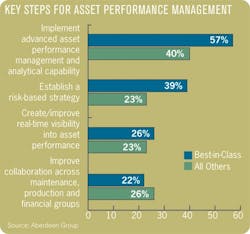Best-In-Class Implement Advanced Asset Performance Management
Jan. 8, 2010
3 min read
The results found Best-in-Class companies performing at the following levels:• 88 percent Overall Equipment Effectiveness (OEE) vs. 75 percent for Laggards• 2 percent unscheduled asset downtime vs. 18 percent for Laggards• 25 percent Return on Assets (RoA) vs. -10 percent for Laggards.The survey respondents were asked to select the top three goals of their chief financial officers (CFOs). The top goal of cutting operating expense is not a surprise, considering the current business landscape. While 63 percent of CFOs will reduce operating expenses in the near term, these executives are also forced to ensure that they are focused on improving profitability and revenue growth over the long term. This balancing challenge of improving profitability and revenue under reduced budget will be a key focus for CFOs as the economy slowly recovers in the next 12 months.The results also indicated that CFOs of Best-in-Class companies are more than 60 percent as likely as others to have goals around risk management in the next year. Establishing a risk-based strategy will provide them with a harmonized view of the risk that impacts different parts of their organizations and will enable them to create a strategy to proactively address those risks, thus minimizing operational, financial and brand image loss.What is it?Asset performance management (APM) is a term that is not well defined in the industry. According to Jay Shellogg, superintendent of Reliability at Domtar Corp., Ashdown, Ark., “To be profitable for the long-term against lower-cost offshore competition, we need to ensure our equipment operates at peak levels at all times. We consider asset performance management one of the greatest opportunities to improve operational and financial results without incurring capital expenditures.” The key concepts within Asset Performance Management are highlighted by the top four strategic actions established by Best-in-Class companies (see chart)—implement advanced APM, establish risk-based strategy, improve real-time visibility into asset performance, and improve collaboration across maintenance, production and finance groups.The top strategy that differentiates Best-in-Class performers is to implement advanced APM and analytical capabilities. This is a key strategy to establish as companies move from reactive to predictive asset management. The successful execution of this strategy requires companies to enable real-time visibility into asset performance, a strategy that also differentiates Best-in-Class performance. Best-in-Class companies are empowering their employees with real-time visibility and are adopting analytical capabilities that enable predictive asset management programs. Best-in-Class companies are nearly 70 percent as likely as their competitors to adopt a risk-based strategy to enable efficient decision making. According to Steven J. Cooke, senior quality management engineer at ADGAS, Abu Dhabi, United Arab Emirates, “We use Risk Based Inspections (RBI) in our inspections department and various statistical methodologies for risk analysis and mitigation. The programs have helped us to reduce unnecessary work and focus resources on critical needs. The data value has increased with better collection, storage, retrieval and analysis capabilities.”Finally, the last strategy that is critical for a successful APM program is to enable collaboration among maintenance, production and financial groups. Best-in-Class companies have already addressed the cultural hurdle of enabling collaboration and are now focused on enabling these cross-functional groups with real-time information to implement advanced asset management capabilities.Mehul Shah, [email protected], is Research Analyst, and Matthew Littlefield, [email protected], is Senior Research Analyst, at Aberdeen Group Inc., in Boston.
Subscribe to Automation World's RSS Feeds for Columns & Departments
About the Author
Sign up for our eNewsletters
Get the latest news and updates

Leaders relevant to this article:
